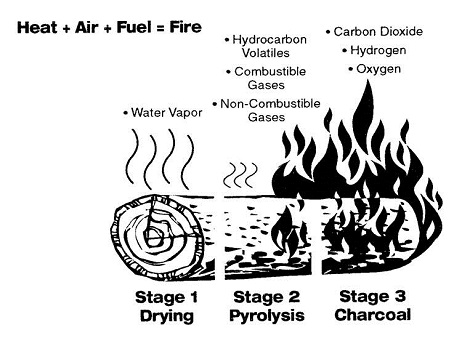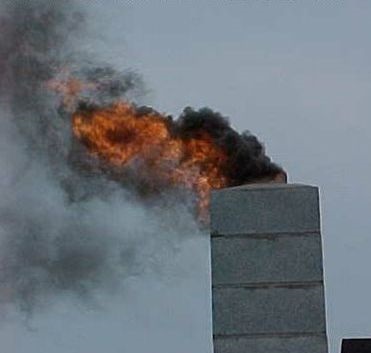 |
> E&O/GL Insurance for Home Inspectors Competitive Rates, Broad Coverage, Free Risk Management, online inspection support for tough questions, discounts on education and more… Professional Coverage, Competitive Pricing Shop OREP today! |
What Home Inspectors Need to Know About Chimneys
by Russ Dimmitt, Chimney Safety Institute of America
Chimneys can be a bit of a mystery. They are not only something that many homeowners never think about but they are dark, dank and oftentimes smelly. For home inspectors, it is important to understand what a chimney is and isn’t, what the standard of care is when inspecting a chimney and what sort of defects might commonly be found in chimneys.
A chimney is defined as a vertical or nearly vertical structure that contains one or more flues for conveying the products of combustion to the outside atmosphere. A vent differs from a chimney in that they are only designed to vent the products of combustion from certain gas, oil or pellet-fired appliances. In other words, a chimney can serve as a vent but a vent cannot serve as a chimney. Residential chimneys can be constructed of either masonry or metal.
Masonry chimneys should be constructed according to standards or the code in force at the time of construction. Unfortunately that often is not the case. Metal chimneys are often referred to by terms such as pre-fabs or factory-built. There are two common, basic styles of factory-built chimneys. One type of factory-built chimney uses insulation that is normally double wall. The other type of masonry chimney utilizes air or air in combination with insulation; these may be double or triple wall. Vents are constructed of metal and utilize the similar insulation methods as those found in chimneys. Codes and standards typically defer to the manufacturer’s listing of a metal chimney for installation and clearance requirements.
The measuring stick typically used by chimney inspectors is either the IRC (International Residential Code) for one and two family dwellings, or the NFPA 211, published by the National Fire Protection Association for Chimneys, Fireplaces, Vents and Solid Fuel Burning Appliances. Manufacturers’ listing and installation instructions are used to determine proper installation and condition of factory-built chimneys and vents. IRC and NFPA 211 are similar in many requirements. NFPA 211 includes chapters on maintenance and standards of inspection of existing chimneys which are not found in IRC. The NFPA 211 is considered the Standard of Care regarding inspections. Consult NFPA 211 for exact language and additional explanation. NFPA 211 spells out the scope, degree of access required, circumstances and indications for each level of inspection. NFPA 211 delineates three levels of inspection with each being more intrusive.
Levels of Inspection
A Level One inspection is required during routine cleaning of a chimney flue or, upon direct replacement of an appliance that is similar in all aspects. The degree of access required for a Level One inspection is: all readily accessible portions of the chimney’s exterior and interior and accessible portions of the appliance and connection. As part of a Level One, it must be verified that the flue does not contain any obstructions or combustible deposits.
A Level Two inspection is required upon removal of an appliance (whether in a flue or still in use), or replacement of an appliance with a dissimilar one, prior to relining a flue, when there is an operating malfunction or external event likely to have caused damage to the chimney and upon sale or transfer of a property. The requirements for this level of inspection are all the requirements of a level one inspection, plus areas within accessible attics, crawl spaces and basements. A Level Two inspection also includes a video scan or other means to do an interior inspection of the flue. As part of a Level Two inspection, proper clearances from combustibles in accessible areas must be verified along with verifying the flues are of a suitable size and material. It will be common for a Level Two inspection to be called for in the course of a home inspectors work.
Level Three inspections require some degree of destruction or disassembly, as hidden portions of the system must be accessed. This level of inspection is not as commonly performed as the first two levels of inspection. Level Three inspections are triggered when there is suspicion of an issue that cannot be properly evaluated with a Level One or Two inspection.
One question many home inspectors have is whether they are required to perform a video scanning of a chimney flue. While the level two inspection calls for an internal inspection of the flue with a video scan system or other means, a video scan is considered the proper way to perform this inspection. Field experience and controlled testing have both shown that various visual inspections with different technologies are inferior to a video scan. Video inspection systems are readily available at a wide range of price points.
Defects
Defects in chimneys fall into four categories:
• Latent defects
• Wear and tear
• Moisture/condensation
• Sudden occurrence
One defect may allow another to happen. For example, an improperly constructed chimney crown, considered a latent defect, would allow water to enter the chimney and accelerate deterioration. It is important to remember that the inspector is only required to follow the prescribed level of inspection and that it is allowable to perform some portion function of the next level of inspection, without performing a full inspection to the next level.
Latent Defects
A latent defect would be one that was part of incorrect initial chimney construction. Latent defects are not commonly found in the construction of factory built systems due to quality control in the manufacturing process. There may be latent defects in the installation of factory-built systems, such as improper clearances or improper component usage. In order to be certain a factory-built chimney is properly installed, it is necessary to have the installation instructions in hand. Common latent defects that are found in masonry chimney construction include improper crown, improper clearances, improper materials and poor-quality workmanship.
A proper chimney crown is often lacking on masonry chimneys. In many areas of the country, chimneys are often topped off with a mortar wash that runs from the flue tile to the edge of the brick. This results in moisture damage to the brick or stone chimney structure. The mortar wash allows rain to run down the side of the chimney and be absorbed into the masonry. In addition, these washes often crack and allow water into the flue cavity. If the mortar is placed against the flue tile, as is commonly done, the lack of room for expansion will cause cracking of both the flue tile and the wash itself.
A properly constructed chimney crown has several features. The crown is poured of concrete rather than mortar. There is a minimum thickness of four inches next to the flue tile and a slope to a minimum thickness of two inches on the outer edge. There is a drip edge in the bottom of the crown to divert water away from the chimney structure. There is a bond break next to the tile allowing for expansion. This gap is filled with silicone sealant or other compressive material. In addition, there is a bond break and flashing under the crown, isolating it from the brick or stone chimney. If one were strong enough, a properly constructed chimney crown could be lifted off the chimney.
Clearances to combustibles are a common issue with masonry chimneys. Internal chimneys should have a minimum clearance of two inches to combustibles and external chimneys should have a minimum clearance of one inch from combustibles. This is often not the case. While less than the required minimum clearances
may not cause a fire immediately, a potential hazard still exists. Combustible materials exposed to heat start to pyrolize. Pyrolization is the first step of combustion. The temperatures that start the process of pyrolization are relatively low, in the mid-200 degree range. The more pyrolization that has occurred, the lower the temperature of combustion becomes. Masonry materials absorb heat and continue to conduct that heat to the surrounding materials after the heat source is gone. (See Figure 1, Stages of Combustion.)

Figure 1: Stages of Combustion
Wear and Tear
Wear and tear take a myriad of forms, however, inspectors will usually only see deterioration from heat, expansion and contraction, settling and general weathering.
Moisture/Condensation
Many feel that a masonry structure, such as a chimney, are permanent but this is not the case. Water is the number one enemy of masonry. Damage takes two forms: either mortar or brick softening and failing and/or freeze thaw damage. Chimneys that lack a rain cap allow water to enter the chimney flue. All flue gases contain some level of acid that vary by fuel type. Water entry into the flue make these acids more active and accelerate deterioration. While codes and standards have called for a non-water soluble refractory between tiles since the early 1990s, older chimneys may not have it. Even newer chimneys may have the same mortar used to build the chimney between the tiles. These missing mortar joints allow flue gases to escape and cause chimney deterioration and flammable products to exit the flue. Because water expands when it freezes, any water absorbed by the masonry causes damage when freezing temperatures are reached. Flue tiles and joints will be broken down by this freezing. The brick or stone structure itself will also suffer damage. The first sign often noticed on the structure itself is spalling or delamination of the bricks with the faces popping off.
Water entry in masonry chimneys can occur in several ways, including faulty washes and crowns, bad or incorrectly installed flashings and incorrectly applied waterproofing. Proper waterproofing materials are breathable to allow moisture to escape but not allow entry of more moisture.
One avenue of water entry that is often overlooked is water from inside the chimney. This is most commonly seen when venting gas-fired appliances into a chimney. When burning either natural gas or liquid propane, approximately one gallon of water vapor is produced for every 100,000 BTUs of fuel burned. If the flue gases cool enough in the flue to condense, that condensate either soaks into the flue tiles and joints or the chimney structure and the deterioration starts.
Sudden Occurrences
The most commonly thought of sudden occurrence is a chimney fire (See Figure 2, Chimney Fire). However there can be other thermal events that would fall into this category, as they cause the same sort of damages. Clay flue tiles function well under normal operating temperatures but can fail with sudden temperature changes. Thermal damage is most often seen on flues venting wood-fired appliances but can occur with any fuel. Flue tiles are a ceramic and a dense material. The mechanics of flue tile failure are due to temperature differences between the outer and inner surfaces of the tile.

Figure 2: Chimney on Fire
Rapid heating of the inner surface causes expansion. While the inner surface is attempting to expand, the outer is relatively cool. This stress between the two surfaces causes a longitudinal crack to occur. The cracks may go other directions but always start longitudinally. This rapid rise in temperature may be caused by a chimney fire which can reach temperatures over 2,000 degrees Fahrenheit. A quick, hot fire can cause the same thermal expansion and crack flue tiles without a chimney fire occurring. When flue tiles are cracked they can no longer contain the products of combustion and are no longer suitable for use.
It is important that home inspectors be aware of the standard of care for a chimney inspection. We have listed some of the shortcomings found in chimneys. A great source for inspectors, when they encounter things that they are not comfortable or experienced with, or when they need to have a video inspection performed, is the Chimney Safety Institute of America and a local Certified Chimney Sweep®. Visit www.csia.org for a list of chimney experts near you and for great homeowner resources.
Free Risk Management Online Course Claims and Complaints: How to Stay Out of Trouble
Available Now
Presenter: David Brauner, Senior Insurance Broker OREP
David Brauner, Senior Broker at OREP, shares insights and advice gained over 25+ years of providing E&O insurance for inspectors, showing you how to protect yourself and your business. Watch Now!
About the Author
Russ Dimmitt is the Director of Education for the Chimney Safety Institute of America and the National Chimney Sweep Guild. Connect with Russ via www.csia.org.
Note: The Winter 2019 issue of Working RE Inspector mailed to over 20,000 home inspectors nationwide. OREP Insureds enjoy guaranteed delivery of each print magazine and many more benefits.
OREP Appraiser E&O insureds enjoy it free and this year Free Approved Continuing Education!!



